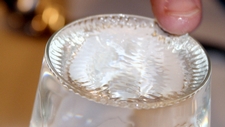Sound

TEKS Objective
The student is expected to differentiate among forms of energy, including mechanical, sound, electrical, light, and heat/thermal.
Essential Understanding
The student knows that energy exists in many forms and can be observed in cycles, patterns, and systems.
Science Background
A Sound Education: K8 Science (video) - Overview of the physical science of sound by Dr. Greg Vogt.
A Sound Education
by Greg Vogt, BioEd Online's YouTube Channel, www.youtube.com/user/BioEdOnline
Wacky Waves: K8 Science (video) - Dr. Greg Vogt uses springs and a slinky to demonstrate how sound is carried in waves. (For instructions to all activities shown on the video, visit the Extensions section at the bottom of this page.)
Wacky Waves
by Greg Vogt, BioEd Online's YouTube Channel, www.youtube.com/user/BioEdOnline
Introduction to Energy: The NEED Project (PDF) - Explains different energy sources and the usage levels for various energy sources in the United States.
Signature Lesson
The Phenomenon of Sound: Waves (website) - Students will experience sound energy as compression waves through a series of investigations.
- Supporting Lessons
- Extensions
- Assessment Ideas
- Literature Connections
- Related
TEKS - Additional Resources
Supporting Lessons
Sensational Sound: Science NetLinks (website) - Students build a “Hanger Clanger” to explore the movement of sound though solids and gases.
Sensational Sound
Science NetLinks, sciencenetlinks.com
The Phenomenon of Sound, Waves: Discovery Education (website) - Students explore sound in a variety of conditions. At the end of the lesson, students will understand that sound is a form of energy, produced by vibrations, that travels in waves.
Elaboration Lessons and Extensions
Slink Around: K8Science (PDF) - Simple activity that demonstrates how sound energy is transmitted along a spring.
Slink Around
K8 Science, www.k8science.org
Resonate! K8Science (PDF) - Demonstrations show how sound energy is transferred with the resonance.
Resonate!
K8 Science, www.k8science.org
Washtub Bass: K8Science (PDF) – Build an instrument to use with your class, and explore vibration and pitch.
Washtub Bass
K8 Science, www.k8science.org
Soup Can Phone: K8Science (PDF) – Vibrations along a taut string carry sound waves, as evidenced by soap can phones.
Assessment Ideas
Have students explore sound pitch by creating and “playing” their own homemade instruments.
Literature Connections
The Wizard of Sound, Mitchell, B. (ISBN: 978-0876144459)
Polar Bear, Polar Bear What Do You Hear? Martin, Bill (ISBN-13: 978-0312513467)
Simple First Sounds: Noisy Trucks. Priddy, Roger (ISBN-13: 978-0312509248)
Sound. Stille, Darlene (ISBN-13: 978-0756509781)
Additional Resources
Your Ears: Kids Health (website) - This interactive article shows the structure of our ears and explains how humans hear sound.
Your Ears
Kids Health, www.kidshealth.org
Glass Xylophone: PBS Kids (website) - Make a “xylophone” from drinking glasses filled with different quantities of water and use it to explore sound energy, pitch and related concepts.
TEKS Navigation
Grade 4
Need Assistance?
If you need help or have a question please use the links below to help resolve your problem.

Comments